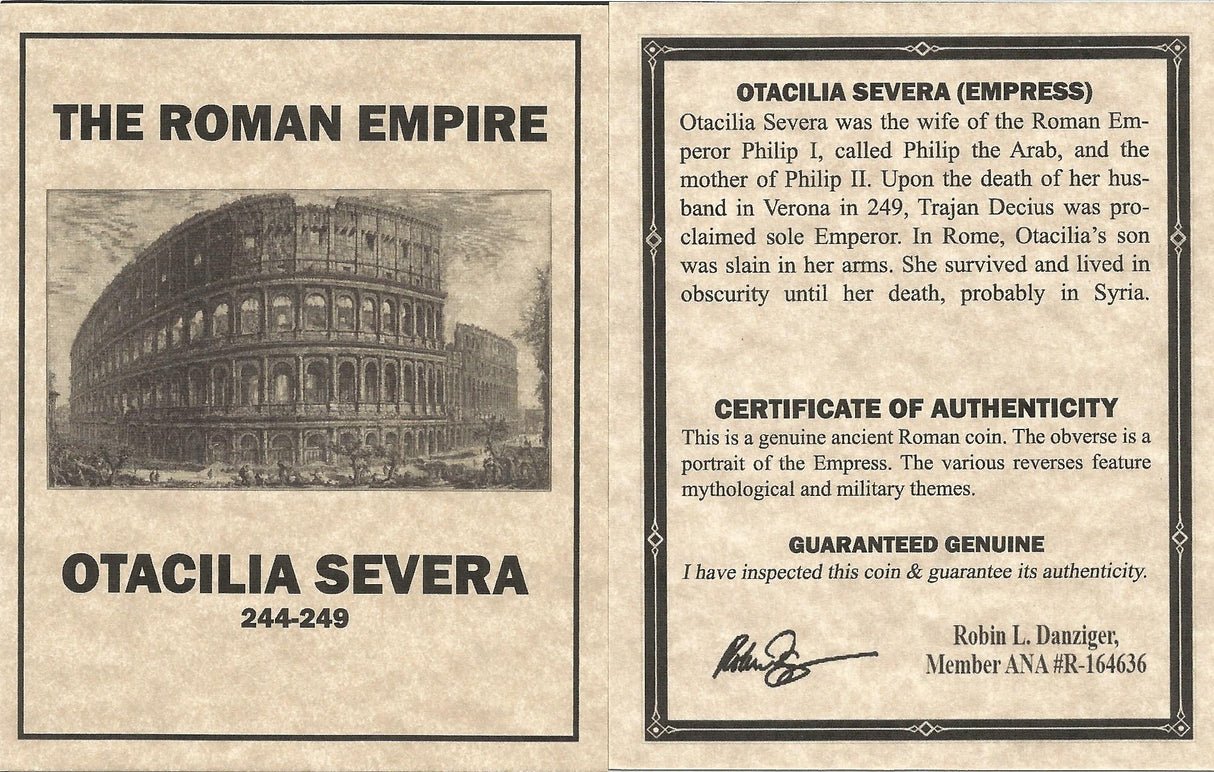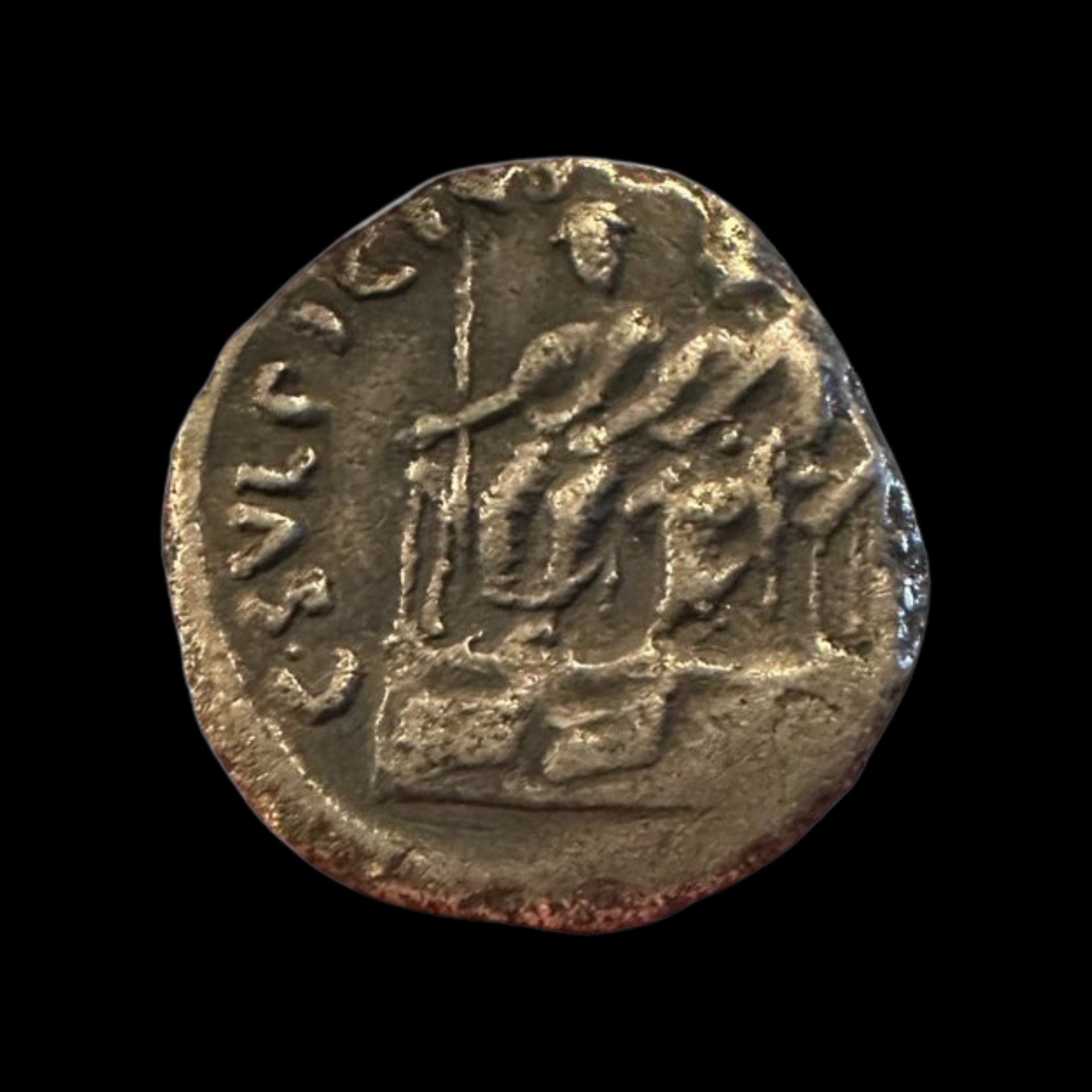 Image 1 of 3
Image 1 of 3

 Image 2 of 3
Image 2 of 3

 Image 3 of 3
Image 3 of 3




Ancient Silver Denarius from the Roman Empire: Emperor Commodus, Struck in Rome (about 1,840 years ago)
This silver denarius was minted in Rome between AD 177 and 192 during the rule of Emperor Commodus, son of the famed Marcus Aurelius. Commodus’s reign marked a dramatic turning point in Roman history, as the stoic discipline of the Antonine era gave way to increasing autocracy and spectacle. Though often remembered for his eccentric behavior and gladiatorial obsession, Commodus used coinage like this to promote traditional Roman virtues and divine favor, even as imperial stability began to erode.
Front side (Obverse):
Laureate head of Commodus facing right
Sharp facial features: curly hair, prominent nose, and imperial beard
Inscribed with his official titles, reinforcing his authority as Augustus
Portrait conveys both youthful vigor and dynastic continuity from Marcus Aurelius
Back side (Reverse):
Depicts a deity or allegorical figure such as Hercules, Pax (Peace), or Providentia, depending on issue
Often shown standing, holding symbolic objects (e.g., cornucopia, scepter, globe)
Legends align Commodus with divine protection, prosperity, and cosmic order
High-relief style with balanced composition, typical of late Antonine minting
Technical Details
Composition: Silver (AR)
Denomination & Weight: Denarius; typically ~3.0–3.5 grams
Mint & Date: Rome Mint, AD 177–192
References: RIC III 1–264 (varies by type); BMCRE 1–350; Cohen references by type
Certification: NGC-certified (Numismatic Guaranty Corporation)
Holder includes grade and strike details (e.g., “Ch VF,” “Fine Style,” etc.)
Guaranteed authentic and protected for long-term preservation
Historical Significance
Commodus’s denarii serve as both historical documents and imperial propaganda—symbols of a Roman emperor caught between inherited greatness and personal decline. Despite his erratic leadership, his coinage maintained the refined artistry and traditional iconography of the High Empire. This certified example is especially prized for its preservation and guaranteed authenticity, making it a compelling piece for collectors interested in the fall of Rome’s golden age. Whether for its portrait of a controversial emperor or its link to a pivotal imperial transition, this denarius is a tangible connection to the final years of Rome’s most illustrious dynasty.
This silver denarius was minted in Rome between AD 177 and 192 during the rule of Emperor Commodus, son of the famed Marcus Aurelius. Commodus’s reign marked a dramatic turning point in Roman history, as the stoic discipline of the Antonine era gave way to increasing autocracy and spectacle. Though often remembered for his eccentric behavior and gladiatorial obsession, Commodus used coinage like this to promote traditional Roman virtues and divine favor, even as imperial stability began to erode.
Front side (Obverse):
Laureate head of Commodus facing right
Sharp facial features: curly hair, prominent nose, and imperial beard
Inscribed with his official titles, reinforcing his authority as Augustus
Portrait conveys both youthful vigor and dynastic continuity from Marcus Aurelius
Back side (Reverse):
Depicts a deity or allegorical figure such as Hercules, Pax (Peace), or Providentia, depending on issue
Often shown standing, holding symbolic objects (e.g., cornucopia, scepter, globe)
Legends align Commodus with divine protection, prosperity, and cosmic order
High-relief style with balanced composition, typical of late Antonine minting
Technical Details
Composition: Silver (AR)
Denomination & Weight: Denarius; typically ~3.0–3.5 grams
Mint & Date: Rome Mint, AD 177–192
References: RIC III 1–264 (varies by type); BMCRE 1–350; Cohen references by type
Certification: NGC-certified (Numismatic Guaranty Corporation)
Holder includes grade and strike details (e.g., “Ch VF,” “Fine Style,” etc.)
Guaranteed authentic and protected for long-term preservation
Historical Significance
Commodus’s denarii serve as both historical documents and imperial propaganda—symbols of a Roman emperor caught between inherited greatness and personal decline. Despite his erratic leadership, his coinage maintained the refined artistry and traditional iconography of the High Empire. This certified example is especially prized for its preservation and guaranteed authenticity, making it a compelling piece for collectors interested in the fall of Rome’s golden age. Whether for its portrait of a controversial emperor or its link to a pivotal imperial transition, this denarius is a tangible connection to the final years of Rome’s most illustrious dynasty.
This silver denarius was minted in Rome between AD 177 and 192 during the rule of Emperor Commodus, son of the famed Marcus Aurelius. Commodus’s reign marked a dramatic turning point in Roman history, as the stoic discipline of the Antonine era gave way to increasing autocracy and spectacle. Though often remembered for his eccentric behavior and gladiatorial obsession, Commodus used coinage like this to promote traditional Roman virtues and divine favor, even as imperial stability began to erode.
Front side (Obverse):
Laureate head of Commodus facing right
Sharp facial features: curly hair, prominent nose, and imperial beard
Inscribed with his official titles, reinforcing his authority as Augustus
Portrait conveys both youthful vigor and dynastic continuity from Marcus Aurelius
Back side (Reverse):
Depicts a deity or allegorical figure such as Hercules, Pax (Peace), or Providentia, depending on issue
Often shown standing, holding symbolic objects (e.g., cornucopia, scepter, globe)
Legends align Commodus with divine protection, prosperity, and cosmic order
High-relief style with balanced composition, typical of late Antonine minting
Technical Details
Composition: Silver (AR)
Denomination & Weight: Denarius; typically ~3.0–3.5 grams
Mint & Date: Rome Mint, AD 177–192
References: RIC III 1–264 (varies by type); BMCRE 1–350; Cohen references by type
Certification: NGC-certified (Numismatic Guaranty Corporation)
Holder includes grade and strike details (e.g., “Ch VF,” “Fine Style,” etc.)
Guaranteed authentic and protected for long-term preservation
Historical Significance
Commodus’s denarii serve as both historical documents and imperial propaganda—symbols of a Roman emperor caught between inherited greatness and personal decline. Despite his erratic leadership, his coinage maintained the refined artistry and traditional iconography of the High Empire. This certified example is especially prized for its preservation and guaranteed authenticity, making it a compelling piece for collectors interested in the fall of Rome’s golden age. Whether for its portrait of a controversial emperor or its link to a pivotal imperial transition, this denarius is a tangible connection to the final years of Rome’s most illustrious dynasty.



















